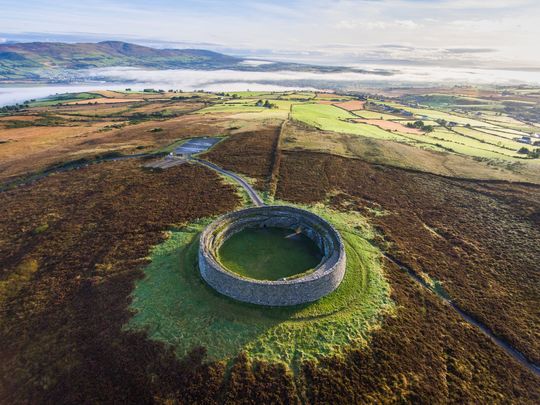The gate from Grianán of Aileach ring fort in County Donegal, associated with the ancient Irish gods Tuatha Dé Danann, has been robbed.
Local Country Donegal press reports that a gate has been stolen from County Donegal's ancient Grianán of Aileach ring fort. The ancient site, in Carrowreagh, Inishowen, is one of Ireland's most impressive circular stone hill-top enclosures.
Dating to pre-Celtic times, this enclosure is believed to have been built 6th and 9th centuries AD but may date back as far as 1700 BC.
On Monday (Oct 27), Donegal Daily reported that "Despite the site being closed under COVID restrictions, thieves made their way up the hill at Burt and cut a lock at the entrance gate, before prizing the gate from the fort itself.
"The incident occurred sometime between 10am Saturday and 10am Sunday, Sunday 25th October.
"Gardaí [Irish police] believe an angle grinder or some implement was used to remove the gate and some form of transport would have been used to transport the gate away.
The historic importance of this spot is immeasurable. The Grianán of Aileach translates to the Sun Temple of Aileach. Located on top of Greenan Hill in Donegal, legend has it that the fort was built by the Great God Dagda.
According to legend, Dagda was a member of the Tuatha Dé Danann: a group of pre-Celtic era race of supernatural beings. Legend and mythology maintain that the Grianán of Aileach was built by Dagda as a burial monument for his dead son.

The entrance to Grianán of Aileach, the location where the gate was stolen.
Outside of mythology, the fort was reportedly built by the Uí Néill dynasty, who used it as a gathering place for clans to discuss important matters.
However, this dynasty only reigned supreme between the 5th and 12th centuries AD and the Grianán of Aileach is one of the Irish sites marked on Ptolemy’s map of the world, which was produced during the 2nd century AD, which would see a structure on the site date back to 140AD.
In the article "Ptolemy's map of Ireland: modern decoding", academics R. Darcy & William Flynn write:
"Claudius Ptolemy (roughly AD 90168) presents us the oldest surviving account of Ireland in the form of a set of coordinates showing different geographical features or a ‘virtual map’. While Ptolemy’s map looks roughly like today’s Ireland there are a number of discrepancies. Likewise, while some locations are obvious, others are disputed or obscure."

The entrance to Grianán of Aileach, in County Donegal, the location where the gate was stolen.
The original stone fort did not survive until the present day, as in 1101 it was destroyed by Uí Néill rival, Murtagh O’Brien the king of Munster.
In 1830, the site was surveyed, and the remains of an early Christian church and a burial mound were identified. In 1860, the monument was restored by Walter Bernard, a doctor and antiquarian from Derry. Alongside Bernard, a Derry-based group called the Irish Irelanders would go to the site each Sunday afternoon to repair and rebuild the monument. The restoration work lasted from 1874 to 1879, resulting in the Grianán of Aileach as we know it today.
With regard to the theft of the gate, authorities are appealing for witnesses or anyone with any information to contact the Buncrana police on +353 74 932 0540 or via the confidential Gardai hotline 1800 6660111.
Read more

Love Irish history? Share your favorite stories with other history buffs in the IrishCentral History Facebook group.




Comments